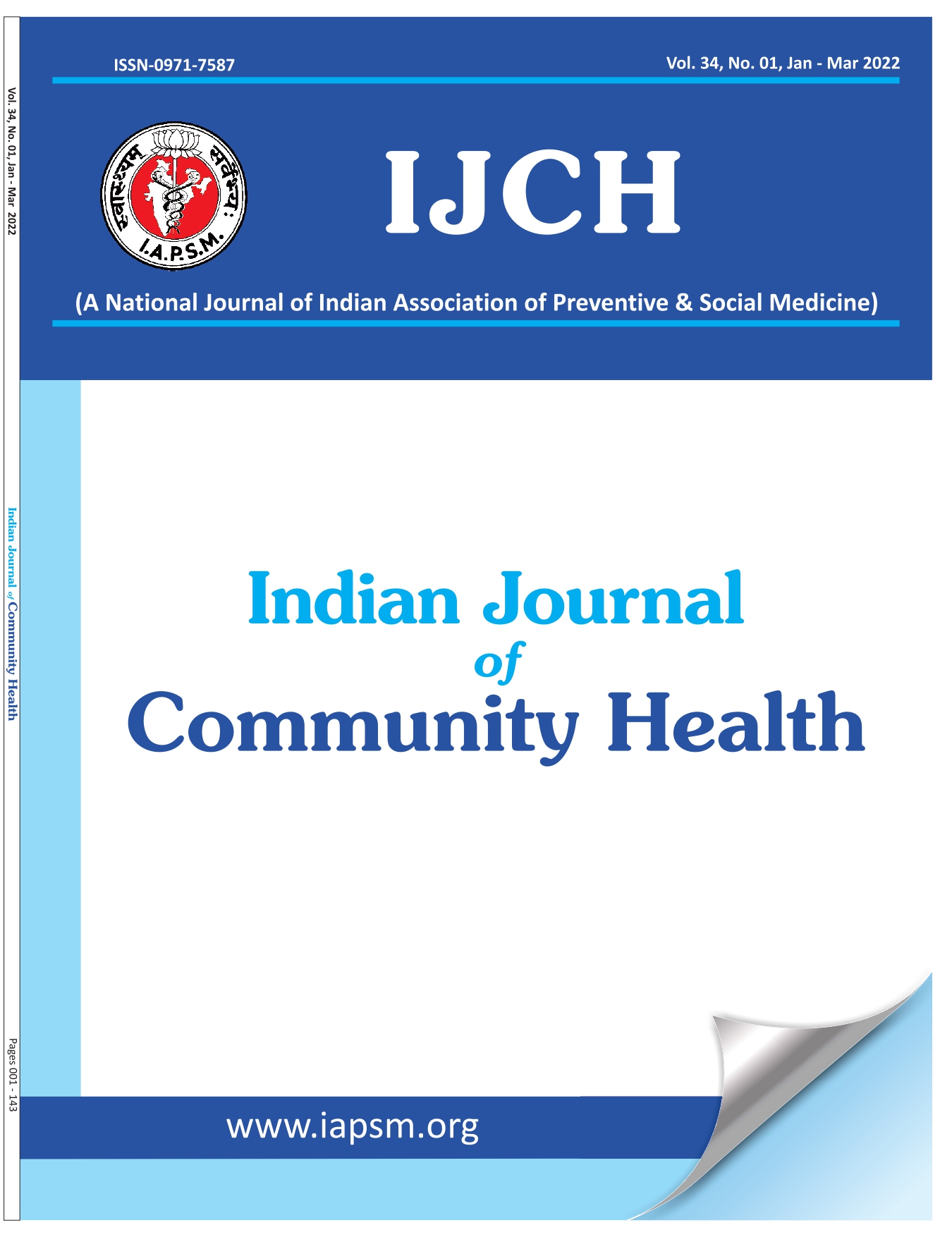Factors influencing HIV testing uptake among priority populations in a resettlement colony of a North Indian city
DOI:
https://doi.org/10.47203/IJCH.2020.v32i01.008Keywords:
Odds Ratio, Cross-Sectional Studies, Sexual Partners, Logistic Models, HIV, Social Stigma, Mass ScreeningAbstract
Background: The recent adoption of HIV ‘test and treat’ strategy by India’s National AIDS Control Organization (NACO) necessitates an urgent need to improve HIV testing among priority populations at risk for HIV. Aim & Objectives: To identify barriers to and facilitators of HIV testing among priority populations such as pregnant women, tuberculosis patients, sexual partners of people living with HIV (PLHIV) and key populations; and to examine the role of new HIV testing modalities (e.g., non-invasive HIV testing) in improving HIV testing. Settings and Design: A cross sectional survey was conducted among priority populations in a resettlement colony of Chandigarh, North India. Materials and methods: A total of 160 participants were recruited using non-probability-based sampling. Statistical analysis used: Chi-square test was used to assess differences between priority populations who had been tested or not tested for HIV. Multivariable logistic regression was conducted to identify significant predictors of HIV testing status. Results: Participants with higher HIV knowledge (Adjusted Odds Ratio [aOR] =1.7, 95% CI 1.2 to 2.5) and family support (aOR=8.2, 95% CI 1.9 to 35.3) had higher odds of getting tested for HIV. Major barriers identified were fear of anticipated discrimination and previous bad experiences in government HIV testing centres, and key facilitators were empathetic attitude of the staff and government initiatives (e.g., free-of-cost tests, reimbursements of travel costs). For periodic testing, priority populations preferred non-invasive (non-blood-based) HIV tests. Conclusions: Interventions to promote HIV testing among priority populations need to reduce HIV-related stigma, and offer non-invasive HIV testing in public hospitals.
Downloads
References
World Health Organization HIV/AIDS. Available at: http://www.who.int/mediacentre/factsheets/fs360/en/. Accessed on Jan 18th, 2019.
Government of India. Annual Report 2016-2017, New Delhi, India: National AIDS Control Organization (NACO); 2017. p340.
Government of India. National Strategic Plan for HIV/AIDS and STI 2017-2024, New Delhi, India: National AIDS Control Organization (NACO); 2017. p31.
World Health Organization. Progress report 2016: Prevent HIV, test and treat all: WHO support for country impact, Geneva, Switzerland: WHO; 2016. p8.
Government of India. National HIV Counselling & Testing Services Guideline, New Delhi, India: National AIDS Control Organization (NACO); 2016. p23.
Government of India. National Strategic Plan for HIV/AIDS and STI (2017–2024), New Delhi, India: National AIDS Control Organization (NACO); 2017. p19.
Woodford MR, Chakrapani V, Newman PA, Shunmugam M. Barriers and facilitators to voluntary HIV testing uptake among communities at high risk of HIV exposure in Chennai, India. Glob Public Health. 2015;11(3):363-76.
Beattie TSH, Bhattacharjee P, Suresh M, Isac S, Ramesh BM, Moses S. Personal, interpersonal and structural challenges to accessing HIV testing, treatment and care services among female sex workers, men who have sex with men and transgender women women in Karnataka state, South India. J Epidemiol Community Health. 2012;66(2):42-8.
Chakrapani V, Mittal S, Gupta V, Kumar R. HIV care cascade for priority populations in Chandigarh. Conference Presentation by Chandigarh State AIDS Control Society (AIDSCON). 2016 Feb 27.
Chanda MM, Perez-Brumer AG, Ortblad KF, Mwale M, Chongo S, Kamungoma N. Barriers and facilitators to HIV testing among Zambian female sex workers in three transit hubs. AIDS Patient Care STDS. 2017;31(7):291-94.
Mohlabane N, Tutshana B, Peltzer K, Mwisongo A. Barriers and facilitators associated with HIV testing uptake in South African health facilities offering HIV Counselling and Testing. Health SA Gesondheid. 2016;21:86-95.
Woodford MR, Newman PA, Chakrapani V, Shunmugam M, Kakinami L. Correlates of HIV testing uptake among kothi-identified men who have sex with men in public sex environments in Chennai, India. AIDS Behav. 2012;16(1):53-62.
Wet HD, Kagee A. Perceived barriers and facilitators to HIV testing in South African communities. J Health Psychol. 2016;23(12):1635-45.
World Health Organization. HIV Testing Services: WHO recommends HIV Self-Testing, Geneva, Switzerland: WHO; 2016. p1.
O’Connor CA, Patsdaughter CA, Grindel CG, Taviera PF, Steinberg JL. A mobile HIV education and testing program: Bringing services to hard-to-reach populations. AIDS Patient Care STDS. 1998;12(12):931–7.
Sharma M, Ying R, Tarr G, Barnabas R. Systematic review and meta-analysis of community and facility-based HIV testing to address linkage to care gaps in sub-Saharan Africa. Nature. 2015;528(7580):S77-85.
Government of India. Annual Report 2008-2009, New Delhi, India: National AIDS Control Organization (NACO); 2009. p15.
Downloads
Published
How to Cite
License
Copyright (c) 2020 Indian Journal of Community Health

This work is licensed under a Creative Commons Attribution-NonCommercial-NoDerivatives 4.0 International License.





